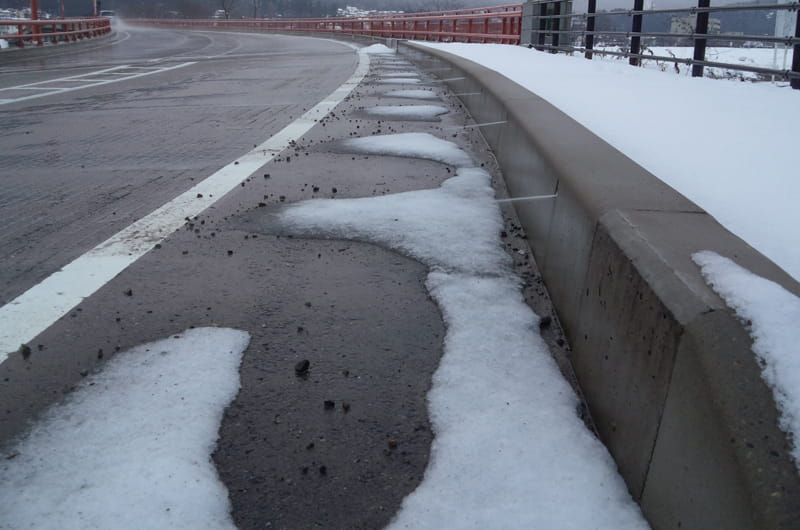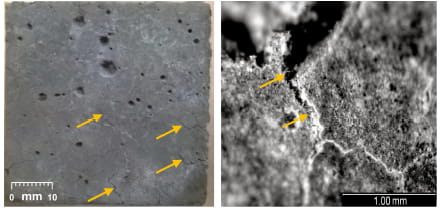Wax On, Melt Off — Researchers Find Adding Paraffin to Concrete Can Help Roads Clear Themselves in The Winter

- Drexel Environmental Collaboratory Releases Cross-Sector Findings on Severe Weather Recovery Challenges
- Drexel Launches the Manuel Stamatakis Center for Alternative Investments at the LeBow College of Business
- How and When Could AI Be Used in Emergency Medicine?
- Faculty Highlights: Recent Awards and Grants

Researchers from Drexel, Purdue and Oregon State have discovered that adding phase change materials, such as paraffin oil, to concrete can give surfaces the ability to melt ice and snow. The discovery means that roads could one day be deiced and snow free without the use of road salts and deicing chemicals.
Drexel University researchers have made a discovery that could create roads that melt off ice and snow during winter storms. Their secret? — Adding a little paraffin wax to the road’s concrete mix.
In a paper recently published in journal “Cement and Concrete Composites” researchers, led by Yaghoob Farnam, PhD, an assistant professor in Drexel’s College of Engineering, explain how substances like paraffin oil — known as “phase change materials” in chemistry — can be used in concrete to store energy and release it as heat when a road needs a melt-off.
Keeping roads open to travel is a persistent challenge during winter months, but efforts to make them safely passable — including the constant use of snow plows, deicing chemicals and road salt — tend to deteriorate the surface. The chemicals and road salts currently used to melt snow and ice can also have a deleterious environmental impact when surface runoff carries them into nearby ecosystems — which is pretty likely considering the state of Pennsylvania alone dumps more than 900,000 tons of it on roads each winter. So researchers have been searching for a better winter option than salting and plowing for some time.
Farnam’s group in collaboration with researchers from Purdue University and Oregon State University, is among the first to demonstrate that using phase change materials as an environmentally friendly alternative can be just as effective as the standard salting and scraping methods.
“Phase change materials can be incorporated into concrete using porous lightweight aggregate or embedded pipes and when PCM transforms from liquid to solid during cooling events, it can release thermal heat that can be used to melt ice and snow,” Farnam said. “By inhibiting the formation of ice and snow on the pavement or bridge surface, the use of PCM may reduce or eliminate the need for deicing chemicals/salts, snowplowing or both — thus saving money and positively influencing the environmental impact of such operations.”
Paraffin oil, a common ingredient in candles, wax polishes, cosmetics and water-proofing compounds, was their material of choice for this endeavor because it is organic, widely available, chemically stable and relatively inexpensive. Like all phase change materials, it releases thermal energy when it changes its physical state, which means as temperatures drop and the oil begins to solidify it releases energy through latent heat of fusion. This means paraffin oil can be tailored to embed deicing capabilities in a road surface so that it becomes thermally active during snow events or when deicing is needed.
To test its snow and ice-melting ability, the team created a set of concrete slabs — one with paraffin-filled pipes inside, one containing porous lightweight aggregate that had been infused with paraffin, and a third reference slab without paraffin. Each was sealed in an insulated container and then covered with about five inches of lab-made “snow.”
With temperatures inside the boxes held between 35-44 degrees Fahrenheit, both of the paraffin-treated slabs were able to completely melt the snow within the first 25 hours of testing, while the snow on the reference sample remained frozen. The slab with the paraffin-filled tubes melted the snow slightly faster than the one composed of paraffin-treated aggregate. Farnam suggests that this is because the paraffin inside the tubes is able to solidify more quickly — thus releasing its energy — because of the regular diameter of the pipes. While the diameter of the pores of the aggregate vary in size.

But in the group’s second experiment, in which the ambient air temperature in the box was lowered to freezing before the snow was added, the paraffin-treated aggregate was more effective than the embedded pipes. This is because the capillary pore pressure delayed the freezing of the paraffin, thus allowing it to release its heat energy over a longer period of time.
“The gradual heat release due to the different pore sizes in porous light-weight aggregate is more beneficial in melting snow when concrete is exposed to variety of temperature changes when snow melting or deicing is needed,” Farnam said. “We believe that using porous lightweight aggregate can be potential way of incorporating phase change materials in concrete as it is easy to be implemented in practice and can cover environmental conditions of various locations in the US dealing with snow, especially melting snow or deicing in roads and bridges in the Northeast.”
One of the first uses of this infrastructure technology could be at airports, where keeping runways clear of snow and ice is vital and a perpetual challenge in the winter. The Federal Aviation Administration supported this research as part of its Heated Airport Pavements Project in its Partnership to Enhance General Aviation Safety, Accessibility and Sustainability program.
“Additional research is needed to further understand other factors influencing concrete constructibility, including concrete fresh and hardened performance when the concrete contains phase change materials, and the phase change material’s thermal performance in different locations in the U.S.,” Farnam said. “Eventually this could be used to reduce the amount of deicing chemicals we use or can be used as a new deicing method to improve the safety of roads and bridges. But before it can be incorporated, we will need to better understand how it affects durability of concrete pavement, skid resistance and long-term stability.”
Drexel News is produced by
University Marketing and Communications.